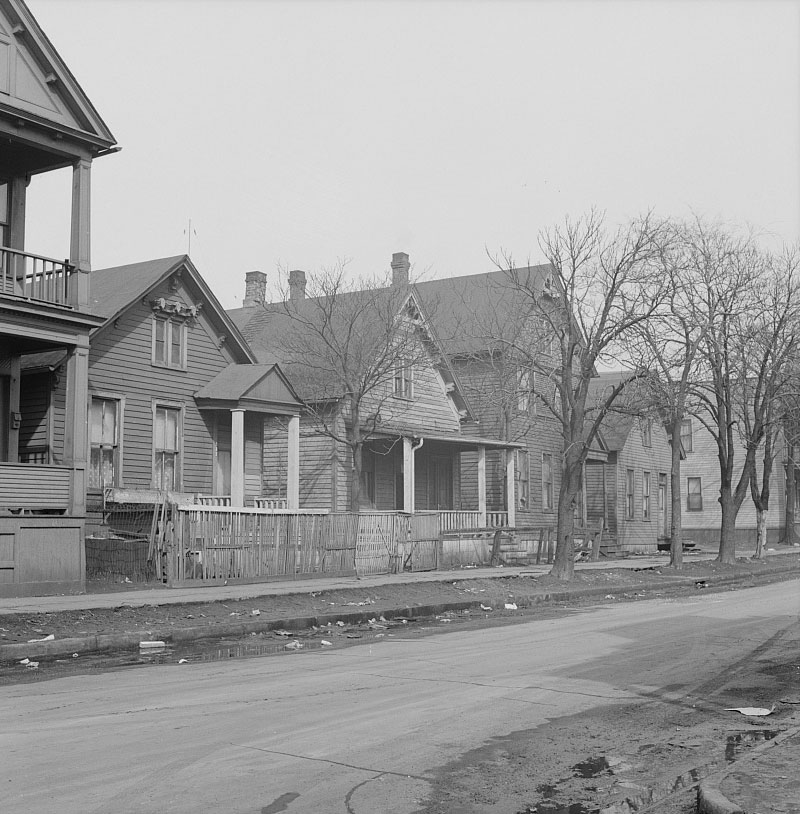Black Neighbors, White Neighborhoods
This is the second installment in our six-part series, “The Long March on Washington.” Click here to read part one, “It’s Our Country, Too,” where we look at the limited wartime opportunities for black Americans in the 1940s.

during the late 1940s. Photo courtesy Library of Congress.
World War II drew the American people together, inspiring them to work toward the single goal of defeating the Axis powers. But the unity wasn’t so great that it could end the nation’s racial division.
Even in the midst of this war, Detroit erupted in a race riot in 1943. The underlying cause was the vast number of black workers who had moved to the city, looking for good paying jobs in war plants. Between 1940 and 1950, Detroit’s population grew 13 percent, but the black population exploded with a 101 percent increase. However, these black workers were only allowed to live in overcrowded, impoverished neighborhoods. The rioting that began in June raged for three days and left 34 dead and 433 wounded.
Then years after the riot, Walter White, secretary of the NAACP, returned to Detroit to assess the state of race relations in the city (“How Detroit Fights Race Hatred,” July 18, 1953). He was cautiously encouraged by what he saw.
Until recently, he wrote, all-white neighborhoods had drawn up covenants that prohibited home sales to blacks, even though the Supreme Court had declared such covenants unconstitutional in 1948. So then, “agreements among real-estate dealers not to show, sell, or rent to Negroes took the place of covenants,” White said. Some mortgage companies and banks helped keep neighborhood segregated by refusing to lend money or grant mortgages to black homebuyers.
Yet slowly, grudgingly, a few all-white neighborhoods had yielded to black buyers. And residents discovered that their property value didn’t suddenly vanish when a black family moved onto the block. White was encouraged by the mayor’s office and police department pledging to protect the lives and property of blacks in any neighborhood. Furthermore, the city was beginning to recruit and train an integrated police force.
[Related article: “When a Negro Moves Next Door” by Ellsworth E. Rosen (April 4, 1959)]
But racial fear ran deep, and the limited advances of integration that White saw in Detroit made little headway against prejudice. In cities throughout the North and South, homeowners were panicking at the thought that black homeowners would leave their “colored” neighborhoods and move next door.
Such fears provoked mistrust, prejudice, and greed that, nine years later, were enriching real estate agents in Chicago known as blockbusters. In “Confessions of a Block-Buster” (July 14, 1962), an anonymous author described his work for the Post: “few white neighborhoods welcome Negroes who can afford to buy there; yet the need for homes for Negroes keeps growing. I assist in the solution of this problem. My function, which might be called a service industry, is to drive the whites from a block whether or not they want to go, then move in Negroes.”
The author was one of several blockbusters in the city who made money by exploiting the fear and prejudice of white homeowners. And the money was good. This unnamed author reported it offered him three sources of profit in his work. The first level of profit came when a panicked seller sold his house at a discount.
“You may believe your home is worth $15,000, for example. If I bust your block, I will expect to buy it for $12,000 cash. The odds are that eventually you will sell for that price, if not to me, then to another speculator.
“Within a few days comes profit No. 2: I advertise and sell it to a Negro not for $15,000, but for $18,000. Financing the deal myself, I will accept $500 to $1,500 down, with the remainder on contract. The easy-payment plan, I believe it is called—that is, $150 to $200 a month until the contract is fulfilled. When is that?
“This is profit No. 3, the big one. The contract is fulfilled when I have been paid principal and interest totaling $36,000.”
The blockbuster’s challenge was finding the first seller. To plant the seed of fear, a blockbusting real estate agent might hire blacks to cruise through the neighborhood or take regular strolls with their children down its sidewalks. Or blockbusters might place anonymous calls to a homeowner and simply say, “They’re coming!”
The author of the article said he didn’t resort to such tactics. He simply told a homeowner that blacks would eventually move into the neighborhood and he, as the real estate agent, was willing to pay cash immediately. When the first “sold” sign appeared on a front lawn, the rest of the neighborhood was easy. White homeowners were convinced that their property value had already begun to disappear.
But the blockbuster never told the sellers the whole truth. “If you and your white neighbors did not run, you probably would gain, rather than lose. More than four-fifths of the white neighborhoods into which Negroes move hold their own or enjoy an increase in value, according to a five-year Fund For The Republic study of 10,000 transactions in Northern interracial neighborhoods.
“But the myth that ‘Negroes lower property values’ persists—so whites run, and we block-busters clean up.”
The neighborhood was just one front on which the battle for integration was being fought. A far more bitter fight would be waged in the schoolhouse.
Coming Next: Integrating the Schools